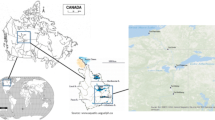Abstract
The cytochrome P450, identified by the characteristic 450 nm spectral peak of its carbon monoxide complex, was detected in the hepatopancreatic microsomes ofMytilus galloprovincialis, collected from Ponteau (Bay of Fos, France) in 1982 and 1983. When mussels were exposed to a variety of petroleum hydrocarbons, the cytochrome P450 content increased. It is shown that aromatic hydrocarbons are more effective than alkanes in inducing a high level of cytochrome P450. The possible use of this haemoprotein in hydrocarbon pollutant detection is discussed.
Similar content being viewed by others
Literature cited
Anderson, J. W., J. M. Neff, B. A. Cox, H. E. Tatem and G. M. Hightower. Characteristics of dispersions and water-soluble extracts of crude and refined oils and their toxicity to estuarine crustaceans and fish. Mar. Biol.27, 75–88 (1974)
Bayne, B. L., K. R. Clarke and M. N. Moore. Some practical considerations in the measurement of pollution effects on bivalve molluscs and some possible ecological consequences. Aquat. Toxicol.1, 159–174 (1981)
Bend, J. R. and M. O. James: Biochemical and biophysical perspectives in marine biology, Vol. 4. 239 pp. New York: Academic Press 1978
Blumer, M., S. Souza and J. Sass: Hydrocarbon pollution of edible shellfish by an oil spill. Mar. Biol.5, 195–202 (1970)
Carlson, G. P.: Detoxification of foreign organic compounds by the quahaugMercenaria mercenaria. Comp. Biochem. Physiol.43B, 295–302 (1972)
Di Salvo, L. H., H. E. Guard and L. Thenter: Tissue hydrocarbon burden of mussels as potential monitor of environmental hydrocarbon insult. Envir. Sci. Technol9, 247–251 (1975)
Elmalmouk, T. H. and T. Gessner: Mixed function oxidases and nitroreductases in hepatopancreas ofHomarus americanus. Comp. Biochem. Physiol.53C, 57–62 (1976)
Klingenberg, M.: Pigments of rat liver microsomes. Archs Biochem. Biophys.75, 376–386 (1958)
Lee, R. F., R. Sauerheber and A. A. Benson: Petroleum hydrocarbons: uptake and discharge by a marine mussel,Mytilus edulis. Science, N.Y.177, 344–346 (1972)
Levin, W., A. Y. H. Lu, D. Ryan, S. West, R. Kuntzman and A. H. Conney: Partial purification and properties of cytochromes P450 and P448 from rat liver microsomes. Archs Biochem. Biophys.153, 543–553 (1972)
Lowry, O. H., N. J. Rosebrough, A. L. Farr and R. J. Randall: Protein measurement with the Folin phenol reagent. J. biol. Chem.193, 265–275 (1951)
McAuliffe, C.: Solubility in water of paraffin, cycloparaffin, olefin, acetylene, cycloolefin and aromatic hydrocarbons. J. phys. Chem., Wash.70, 1267–1275 (1966)
Moore, M. N., D. R. Livingstone, P. Donkin, B. L. Bayne, J. Widdows and D. M. Lowe: Mixed-function oxygenases and xenobiotic detoxification/toxication systems in bivalve molluscs. Helgoländer wiss Meeresunters.33, 273–291 (1980)
Moore, S. F. and R. L. Dwyer: Effects of oil on marine organisms: a critical assessment of published data. Wat. Res.8, 819–827 (1974)
Neff, J. M., B. A. Cox, D. Dixit and J. W. Anderson: Accumulation and release of petroleum-derived aromatic hydrocarbons by four species of marine animals. Mar. Biol.38, 279–289 (1976)
Omura, T. and R. Sato: The carbon monoxide binding pegment of liver microsomes. J. biol. Chem.239, 2370–2378 (1967)
Payne, J. F.: Mixed-function oxidases in marine organisms in relation to petroleum hydrocarbon metabolism and detection. Mar. Pollut. Bull.8, 112–116 (1977)
Pohl, R. J., J. R. Bend, A. M. Guarino and J. R. Fouts: Hepatic microsomal mixed-function oxidase activity of several marine species from coastal Maine. Drug Metab. Disp.2, 545–555 (1974)
Stegeman, J. J., R. L. Binder and A. Orren: Hepatic and extrahepatic microsomal electron transport components and mixed-function oxygenases in the marine fish:Stenotomus versicolor. Biochem. Pharmac.28, 3431–3439 (1979)
Stegeman, J. J. and J. M. Teal: Accumulation, release and retention of petroleum hydrocarbons by the oysterCrassostrea virginica. Mar. Biol.22, 37–44 (1973)
Widdows, J., T. Bakke, B. L. Bayne, P. Donkin, D. R. Livingstone, D. M. Lowe, M. N. Moore, S. V. Evans and S. L. Moore: Responses ofMytilus edulis on exposure to the water-accommodated fraction of North Sea oil. Mar. Biol.67, 15–31 (1982)
Author information
Authors and Affiliations
Additional information
Communicated by J.M. Pérès, Marseille
Rights and permissions
About this article
Cite this article
Gilewicz, M., Guillaume, J.R., Carles, D. et al. Effects of petroleum hydrocarbons on the cytochrome P450 content of the mollusc bivalveMytilus galloprovincialis . Mar. Biol. 80, 155–159 (1984). https://doi.org/10.1007/BF02180182
Accepted:
Issue Date:
DOI: https://doi.org/10.1007/BF02180182




